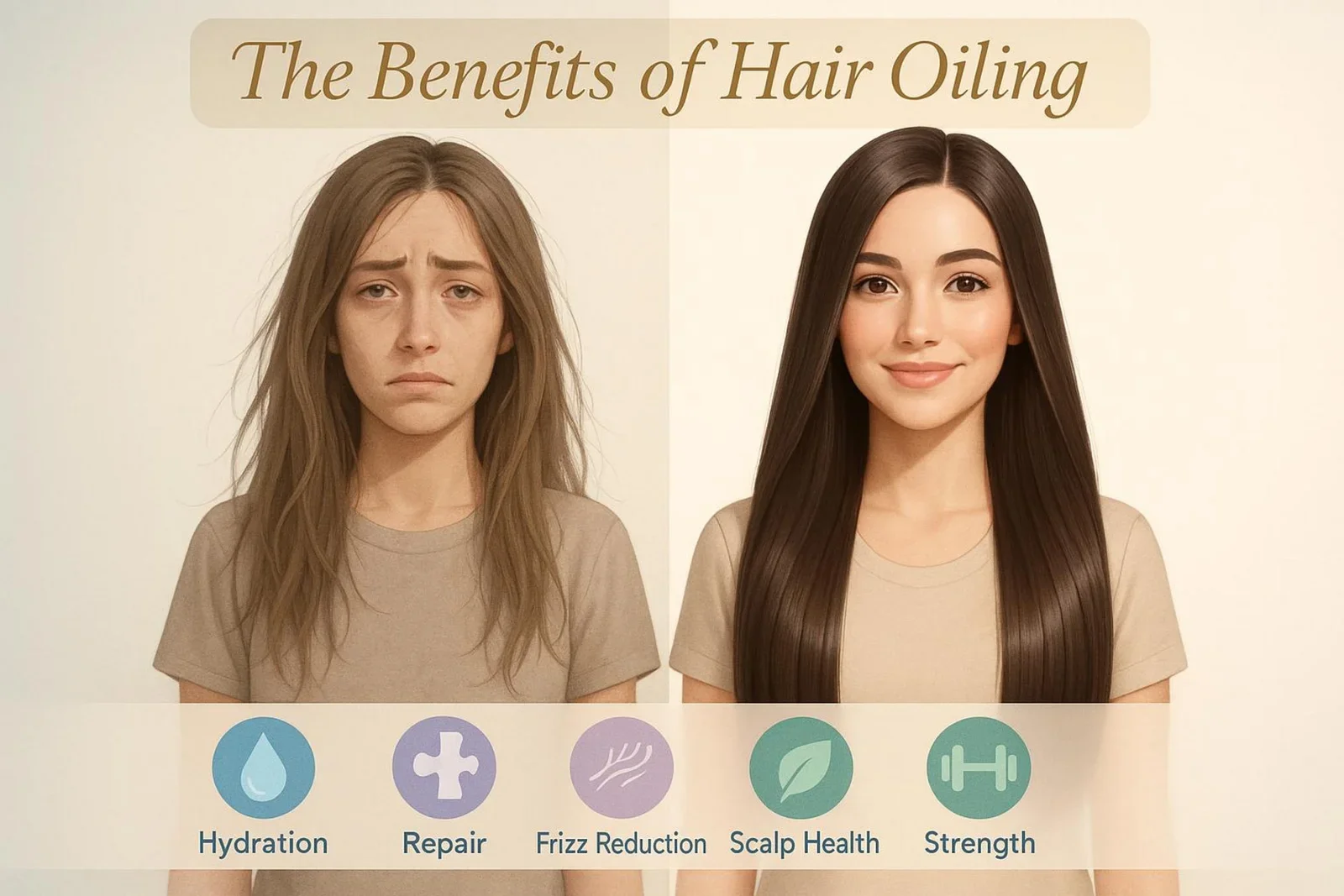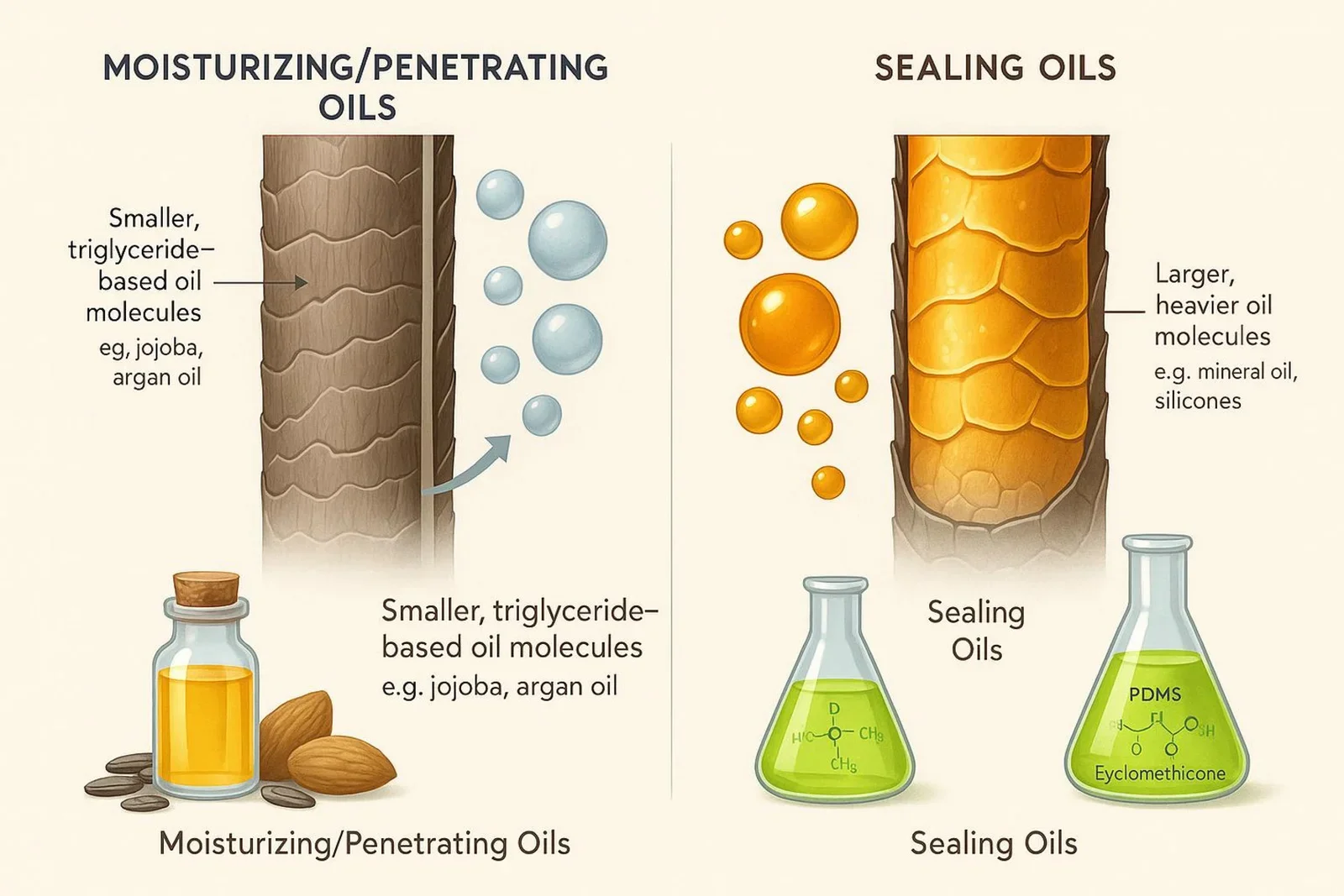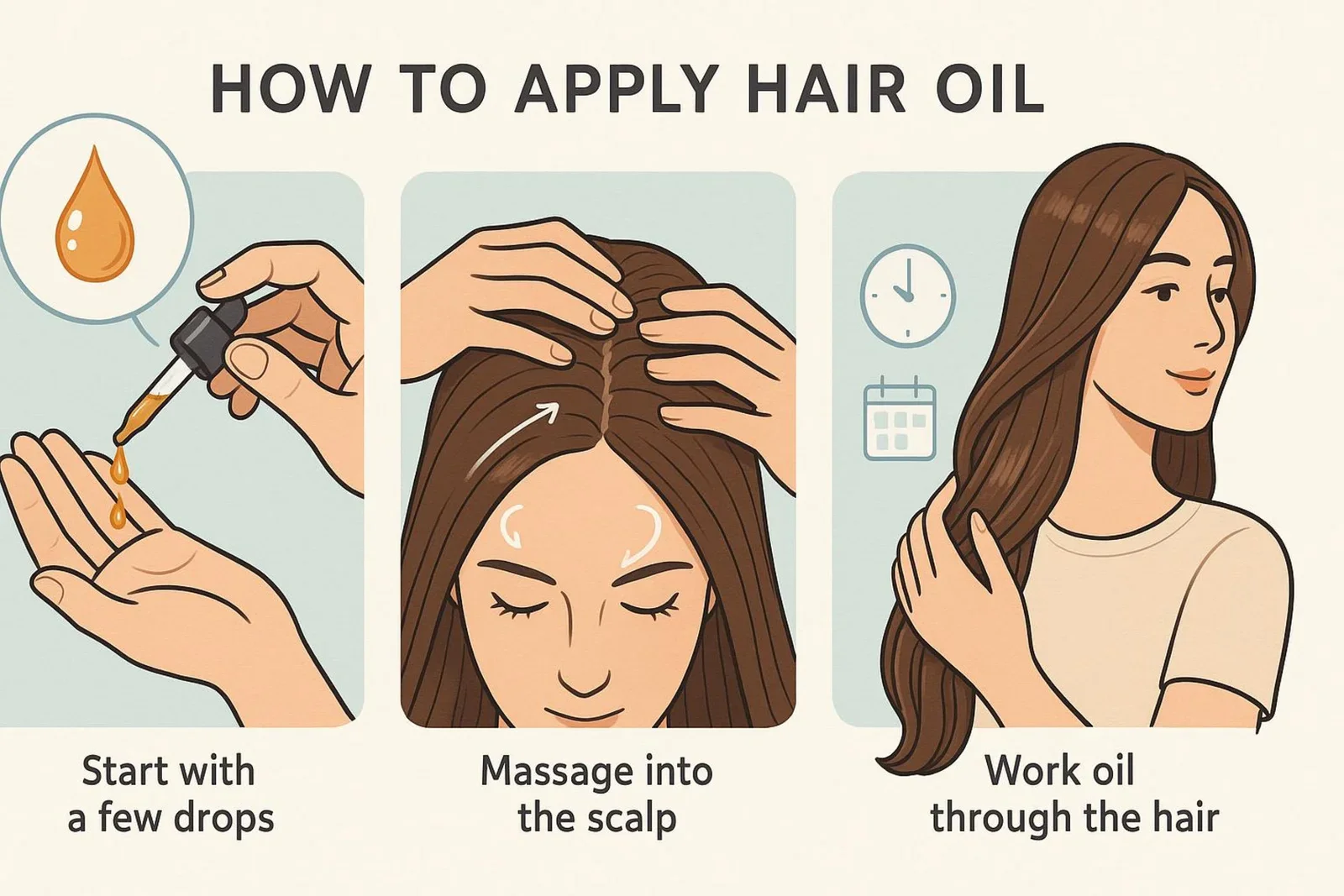Hair Oils 101: How to Pick the Best One for Your Hair Type
Have you ever thought there might be a simple way to get softer, healthier hair? If you haven’t tried using hair oils yet, you might be missing out! Hair oils can make a big difference for all hair types by adding moisture and strength. There are a lot of different oils to choose from, so finding the right one can seem a bit confusing. This guide will break down how hair oils work and help you pick the best one for your hair type, so you can get the results you want without feeling lost.
If you struggle with dryness, frizz, or just want your hair to look shinier, there’s an oil that can help. In this article, we’ll clearly explain what hair oiling is, the different types of oils, what to think about when choosing one, and a few myths you might have heard. Let’s get started-by the end, you’ll know just how to make hair oils work for you!
What Is Hair Oiling and How Can It Help Your Hair?
Hair oiling is an old tradition, especially common in Ayurveda from India, where people apply oil to their hair and scalp before washing it. Recently, this method has become popular again because of its proven benefits for keeping hair healthy and shiny.
Hair oiling is more than just a treat. When you regularly put oil on your hair, you build a shield that keeps moisture in and keeps bad stuff-like sun or pollution-out. This helps your hair stay soft, shiny, and less likely to break or get damaged.
Keeps Hair Hydrated and Soft
When your hair is dry, it can feel rough and look flat. Oiling your hair adds moisture, making it soft and easy to manage. The oil smooths your hair’s surface, stopping water from escaping. Even after you wash the oil out, some moisture stays, keeping your hair softer and smoother for longer.
Helps Repair Damage and Split Ends
Hair is mostly made out of a protein called keratin. Everyday things-like heat styling, coloring, and sun-can weaken this protein. Oiling your hair gives it nutrients and strength, making it less likely to tangle or split at the ends. Trimming your hair is still important, but regular oiling makes damaged hair look and feel better over time.
Reduces Frizz and Adds Shine
Frizz usually means your hair is dry and the surface (cuticle) is rough. Oils help flatten this layer and trap in moisture, which leads to shinier, smoother hair. Certain oils, like argan and coconut, are especially good at fighting frizz. They also protect hair from humidity, which is a common cause of frizz.
Supports Scalp Health and Prevents Flakes
Your scalp makes its own oil, called sebum, to protect your hair. When your scalp makes too much or too little, you can have oily or flaky patches. Massaging oil into your scalp improves blood flow and can even help with hair growth. Some oils, like jojoba, are similar to the oil your scalp naturally produces and can help stop flakes or dryness.
Makes Hair Stronger and Prevents Hair Loss
Everyday actions like brushing or wearing tight ponytails can wear hair down and cause breakage. Oiling makes hair more flexible, so it handles stress better. Some oils, like castor oil, are known for helping hair grow by feeding your hair roots with nutrients. Others, like grapeseed oil, may help stop hormone-related hair loss.
How Do Hair Oils Work and What Kinds Are There?
Hair oils don’t all work the same way. They can either soak into the hair, giving deep moisture and nutrients, or sit on top to seal in moisture and stop damage. Here’s how they differ:
Moisturizing Oils vs. Sealing Oils
Moisturizing (Penetrating) Oils: These go deep into the hair and add moisture from the inside. They carry nutrients that help make hair stronger and more flexible. Great examples are coconut oil, argan oil, and olive oil. These work well for dry, damaged, or porous hair.
Sealing Oils: These coat the outside of your hair and keep moisture from escaping. They don’t soak in much but do a great job adding shine and fighting off frizz. Common sealing oils include jojoba, grapeseed, and black castor oil. These are often put on after you moisturize your hair, or as a final touch for styling.
Plant-Based vs. Synthetic Hair Oils
Plant-Based Oils: Made from seeds, nuts, or fruits, these are natural and often cold-pressed, so they keep their nutrients. Examples are coconut, argan, and jojoba oil. Many people choose these because they don’t have artificial chemicals and work naturally with your hair.
Synthetic Hair Oils: These are made in labs and are often used for quick shine or smoothing, often using silicone. They make hair look shiny fast, but can cause buildup if used too much. Always check labels to see if a product is all-natural or a mix of natural and synthetic oils.
How to Pick the Right Oil for Your Hair Type
No one oil works for everyone. Picking the right one depends on your hair’s thickness, texture, how much moisture it absorbs, and your scalp condition. Here are the key things to look at:
Understand Your Hair Type
| Hair Type | Best Oil Types | Why Chosen |
|---|---|---|
| Fine | Argan, Grapeseed, Almond | Light, doesn’t make hair look flat |
| Thick/Coarse | Coconut, Castor, Olive | Heavy oils add deep moisture |
| Curly/Coily | Coconut, Castor, Avocado | Intense moisture helps define curls and stop frizz |
| Straight | Argan, Jojoba | Light oils add shine without greasiness |
Check Your Hair’s Porosity
Low Porosity: Hair repels water and products often sit on top. Use light oils like argan or jojoba that soak in easily.
Medium Porosity: Hair absorbs and holds moisture well. Most oils will work, so try different kinds and see what suits you.
High Porosity: Hair takes in moisture fast but loses it quickly. Pick heavier oils like coconut, olive, or castor to lock in moisture.
Know Your Scalp Condition
Dry Scalp: Use moisturizing and soothing oils such as jojoba, olive, or coconut. These can help with itchiness and flakes.
Oily Scalp: Try lightweight oils like jojoba or tea tree oil, but use sparingly and mostly before shampooing.
Sensitive Scalp: Gentle oils like jojoba or almond work best. Always do a patch test before using a new oil.
Match Oils to Your Main Hair Concerns
Dandruff: Tea tree and grapeseed oils help with flakes and irritation.
Split Ends: Coconut, olive, and almond oils help make ends smoother.
Hair Loss: Castor and avocado oils can feed hair roots and encourage growth.
Colored Hair: Shea butter and argan oil protect moisture and vibrancy.
Top Hair Oils: What They Do and Who They’re For
| Oil | Best For | Main Benefits |
|---|---|---|
| Coconut Oil | All, but especially thick, curly, or dry hair | Deep nourishment, prevents protein loss, detangles, softens |
| Argan Oil | Fine, medium, or frizzy hair | Adds shine, tames frizz, lightweight hydration |
| Jojoba Oil | Oily or flaky scalp, all hair types | Balances scalp oils, soothes dandruff, non-greasy |
| Olive Oil | Dry, dull, thick, or coarse hair | Softens, strengthens, seals moisture |
| Castor Oil | Damaged, curly, coily hair | Encourages growth, deep moisture, reduces breakage |
| Grapeseed Oil | Fine, brittle, thinning hair | Light, boosts shine, may help with hair loss |
| Tea Tree Oil | Oily or itchy scalp | Clears blocked follicles, reduces dandruff |
| Avocado Oil | Thick, dry, brittle hair | Deep hydration, makes hair stronger, smooths cuticle |
| Almond Oil | Coarse, frizzy, hard-to-manage hair | Softens, fills gaps, boosts shine |
Specialty Oils Worth Trying
Pracaxi Oil: Good for thick, curly hair and adds elasticity.
Baobab Oil: Moisturizes well without leaving hair greasy.
Marula Oil: Boosts scalp circulation and may help hair look thicker.
Flaxseed Oil: Fights inflammation, may reduce dandruff, and adds shine.
Soybean Oil: Improves moisture and adds softness.
How to Apply Hair Oil for Best Results
Choosing the Oil and How Much to Use
Pick an oil that matches your hair’s needs. Start with little-a few drops (about the size of a coin) and use more only if needed. Fine hair needs less; thick or curly hair may need more, but always add slowly.
Step-by-Step Application
Brush or comb out any tangles before you start.
Section your hair if you are oiling your scalp. Put oil on your fingertips and gently massage it into your scalp in circles.
For the lengths, rub oil between your palms and work it into the ends first, then upwards.
Use a wide-tooth comb to spread oil evenly if your hair is thick.
Don’t soak your hair in oil-just coat it lightly.
Should You Apply Oil to Wet or Dry Hair?
Dry Hair: Good for pre-wash treatments or for protecting hair from heat or sun.
Wet/Damp Hair: Helps seal in moisture right after washing. Easier to spread evenly.
Try both ways and see which works best for your hair.
How Often Should You Use Hair Oil?
Normal hair: Once or twice a week is usually enough.
Dry, damaged, or very curly hair: Try every other day, or even daily for the ends.
Oily or fine hair: Limit oiling to once a week and focus on the ends, not the roots.
If you use heat tools: Use a small bit before and after styling for protection.
Start slow and adjust based on how your hair feels.
Should You Rinse Oil Out or Leave It In?
Rinse out (after a treatment): Use for deep conditioning. Leave on for 30 minutes to overnight, then wash out. You may need to shampoo twice.
Leave in (for styling): Use a tiny amount of light oil on the ends for daily shine or to calm flyaways.
Common Hair Oil Mistakes and Myths
Do Oils Clog Pores or Cause Scalp Problems?
Not all oils will block your pores. Lightweight oils like argan and jojoba are usually safe. Be careful with sensitive or problematic scalps, and always wash out oil properly if you’re using it on your scalp.
Do Oils Add Moisture or Just Lock It In?
Some oils, like coconut and argan, can get inside the hair and add moisture. Others, like olive and jojoba, mostly seal moisture in. Knowing which type you’re using helps you get the result you want.
Are All Natural Oils Good for Everyone?
No, not all natural oils are right for every hair or scalp. Heavy oils may make fine hair greasy. Always try a small amount first and see how your hair or scalp reacts.
Frequently Asked Questions
How Often Should I Oil My Hair Ends?
Healthy hair: 1-2 times per week
Dry or damaged ends: Every other day, or daily in small amounts
If heat styling: A dab before and after can help protect ends
Can You Use Too Much Oil?
Yes. Hair can look limp, greasy, or heavy.
Too much oil can cause buildup and even dull hair rather than add shine.
Use small amounts and see how your hair looks and feels.
Which Is Better: Argan or Coconut Oil?
Argan Oil: Best for fine, frizzy, or oily hair. Lightweight, adds shine, controls frizz.
Coconut Oil: Better for thick, dry, curly, or high-porosity hair. Very moisturizing, helps repair damage.
When Should You Avoid Hair Oils?
If you have scalp conditions (like dandruff, dermatitis, or fungal issues), talk to a doctor before using oils.
If you’re using hair loss medicine, ask your doctor first.
If you have allergies, read labels and do a patch test.
Avoid right after heavy chemical treatments until your stylist says it’s safe.
Summary: Picking the Best Hair Oil for You
Finding the best hair oil doesn’t have to be hard. It all comes down to knowing your hair type, porosity, scalp condition, and main hair concern. Using the right oil the right way-consistently but not too much-can make your hair softer, shinier, and healthier. Remember to start with small amounts, experiment to see what works, and adjust as you go. With the right oil and a little patience, you’ll see great results and enjoy stronger, more beautiful hair.
Do you live in Sydney?
Get the perfect look at our salon – schedule your appointment now!
Our Services
Check Out Our Instagram
Check out our instagram
Check out our instagram and see our latest posts!
Check out our facebook
Check out our facebook and see our latest
posts!











